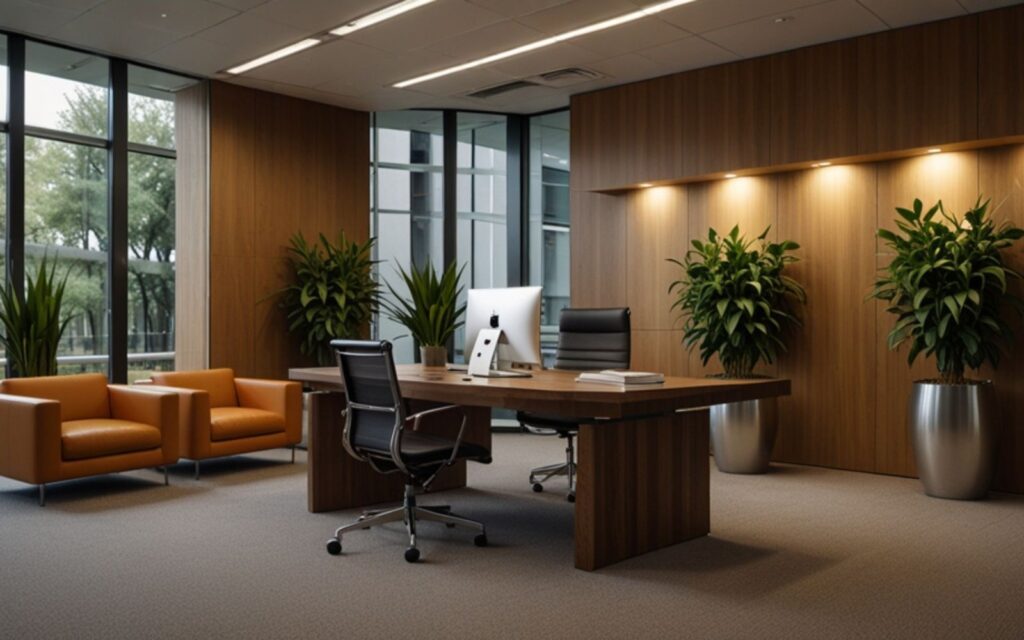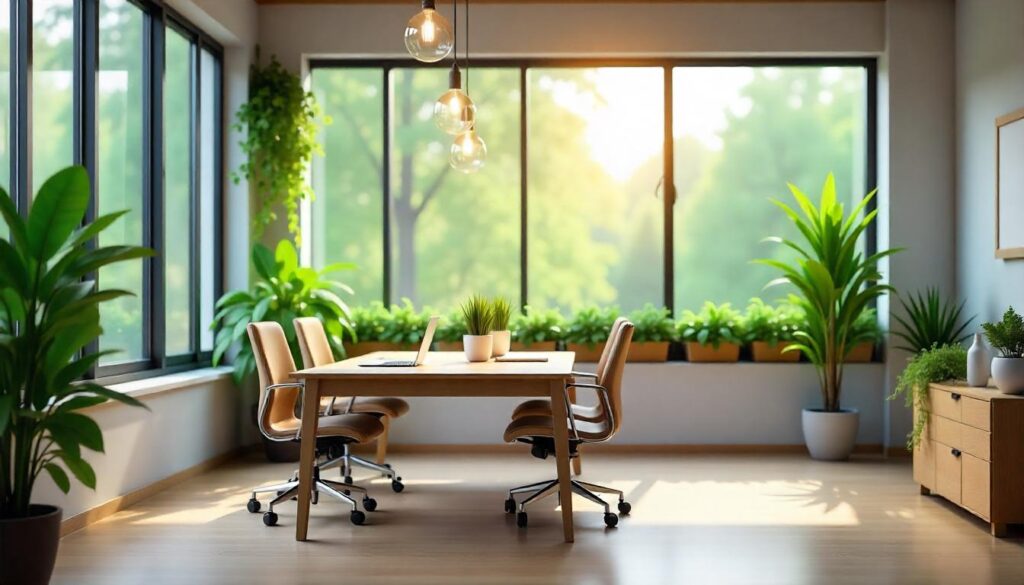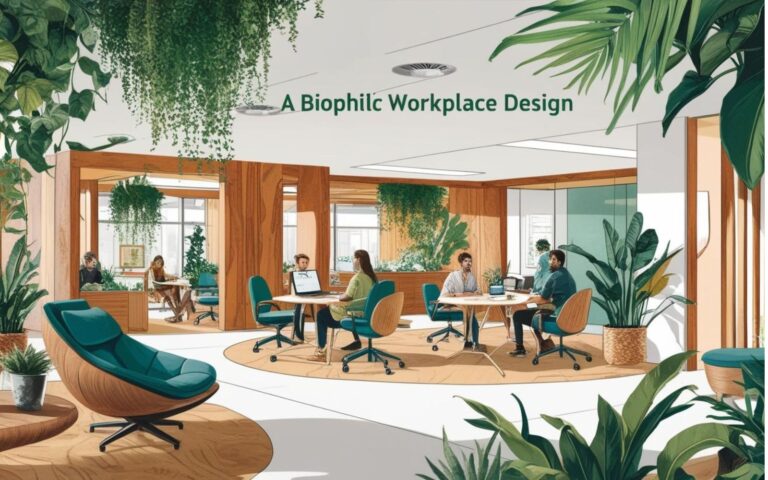The Mental Health Benefits of Eco-Conscious Design for Mindful Living

Modern life can be stressful, but what if your living and working spaces could offer more than just shelter? What if they could actively improve your mental state, reduce stress levels naturally, and promote a deeper connection with the natural world?
Let’s explore the mental health benefits of eco-conscious design, which promotes well-being through sustainable, nature-inspired spaces.
Eco-conscious design offers this opportunity by integrating green spaces, natural materials, and sustainable habits into our daily lives.
The benefits are well-documented. This approach positively impacts not only physical and mental health but also overall well-being.
Key Takeaways
- Eco-conscious design promotes mental well-being by reducing stress and improving overall health.
- Integrating natural elements and green spaces boosts occupant health and self-esteem.
- Sustainable living creates a profound connection to the natural world, leading to a significant decrease in anxiety and depression.
- Small, mindful changes to living and working environments can have a lasting, positive impact on psychological well-being.
What Is Eco-Conscious Design and Its Mental Health Benefits?

Eco-conscious design focuses on creating environments that benefit both the environment and human health. It integrates sustainable materials, energy efficiency, and green spaces into living and working spaces to improve occupant health and well-being.
The Mental Health Benefits
- Natural surroundings foster a deeper connection to nature, which helps reduce stress levels. Green habits, such as incorporating plants and utilizing natural lighting, can enhance emotional well-being and mental wellness. Sustainable design supports both the environment and human well-being by lowering carbon footprints while improving indoor air quality and overall mood.
This combination of eco-friendly principles and mindful living has a profound impact on psychological well-being, making it a key component of the green building revolution.
Reducing Stress Levels With Natural Elements

Stress is a common issue in urban settings and city life. Eco-conscious design addresses this challenge by creating environments that integrate natural settings into daily lives.
How Natural Elements Reduce Stress:
- Indoor plants improve air quality, reduce noise pollution, and promote relaxation. Natural lighting mimics sunlight, boosting serotonin levels and reducing symptoms of depression.
- Natural materials, such as wood and stone, create a sense of grounding and connection to the earth.
Example: Forest Bathing at Home
Inspired by the Japanese practice of forest bathing, creating spaces filled with plants and natural materials helps foster a sense of calm and tranquility.
Spending time in these natural surroundings can lower blood pressure and support both physical and mental health.
The Role of Green Spaces in Promoting Mental Wellness

Access to green spaces is crucial for maintaining emotional and mental well-being, particularly in urban environments.
Parks, gardens, and green roofs provide an escape from the chaos of modern life.
Benefits of Green Spaces:
- Improve cognitive function and mental clarity.
- Promote social factors, such as community connections, which enhance mental well-being.
- Encourage physical activity to benefit both physical and psychological health.
Green buildings that incorporate green spaces can help reduce stress levels and have a positive impact on mental well-being, fostering a sustainable lifestyle for occupants.
Improving Indoor Air Quality for Better Health Outcomes

Toxins from synthetic materials and poor ventilation often pollute the air we breathe inside conventional buildings. Eco-conscious design addresses this by prioritizing air quality.
Strategies to Improve Indoor Air Quality:
- Use non-toxic, low-VOC (volatile organic compound) paints and finishes. Incorporate indoor plants that naturally purify the air. Design spaces with proper ventilation to eliminate harmful pollutants.
Improved indoor air quality has a profound impact on mental wellness and physical well-being, leading to better health outcomes and overall health.
Creating Environments That Promote Relaxation and Productivity

Living and working spaces have a direct influence on our mental state and overall mood. Eco-conscious design creates environments that strike a balance between relaxation and productivity.
How to Create Relaxing Yet Functional Spaces:
- Use energy-efficient lighting to mimic the natural world’s cycles. Add biophilic design elements, such as water features or natural textures, to promote a sense of calmness. Keep spaces clutter-free with sustainable habits, such as repurposing items and minimizing waste.
These choices create spaces that support mental well-being while encouraging a sustainable lifestyle.
The Green Building Revolution: A Step Toward Ecological Sustainability

The green building revolution is transforming how we think about homes and workplaces.
By prioritizing ecological sustainability, green buildings not only enhance occupant well-being but also contribute to the health of the planet.
Key Features of Green Buildings:
- Reduce the carbon footprint by using renewable energy and sustainable materials. Prioritize occupant health by integrating natural elements and promoting a connection with the natural environment.
- Focus on energy efficiency and environmental impacts to support sustainable communities.
The positive impact of this movement is evident: improved mental health, enhanced physical well-being, and a substantial reduction in environmental harm.
Summary
Eco-conscious design offers more than aesthetic appeal. It provides health benefits that improve both physical and mental well-being.
By integrating green spaces and natural elements, this approach fosters a profound connection to the natural world while also improving air quality and enhancing energy efficiency.
By making small, mindful changes, you can transform your daily environment into a space that reduces stress, promotes relaxation, and enhances your overall mood.
Whether through sustainable habits, biophilic design, or the green building revolution, eco-conscious design supports both human health and the planet’s well-being.
Frequently Asked Questions
What Are the Mental Health Benefits of Eco-Conscious Design?
Eco-conscious design reduces stress, enhances emotional well-being, and improves cognitive function by incorporating natural elements and sustainable practices into living spaces.
How Do Green Spaces Impact Mental Wellness?
Green spaces offer a connection to the natural world, promote physical and mental well-being, and foster mindfulness, resulting in a significant reduction in anxiety and depression.
How Does Air Quality Affect Psychological Health?
Better indoor air quality reduces stress levels, improves focus, and supports mental wellness by removing toxins and pollutants from living and working spaces.
What Is Biophilic Design, and Why Is It Important?
Biophilic design incorporates natural elements into built environments, fostering a profound connection to nature and enhancing overall well-being.
Can Eco-Conscious Design Be Affordable and Practical?
Yes! Simple changes, such as using indoor plants, choosing non-toxic materials, and adopting sustainable habits, can have a positive impact without requiring significant investments.





